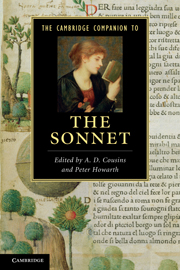Book contents
- Frontmatter
- Introduction
- 1 Contemporary poets and the sonnet
- 2 The sonnet and the lyric mode
- 3 The sonnet, subjectivity and gender
- 4 The English sonnet in manuscript, print and mass media
- 5 European beginnings and transmissions
- 6 Desire, discontent, parody
- 7 Shakespeare’s Sonnets
- 8 Sacred desire, forms of belief
- 9 Survival and change: the sonnet from Milton to the Romantics
- 10 The Romantic sonnet
- 11 The Victorian sonnet
- 12 The modern sonnet
- 13 The contemporary sonnet
- Further reading
- Index
6 - Desire, discontent, parody
the love sonnet in early modern England
Published online by Cambridge University Press: 28 May 2011
- Frontmatter
- Introduction
- 1 Contemporary poets and the sonnet
- 2 The sonnet and the lyric mode
- 3 The sonnet, subjectivity and gender
- 4 The English sonnet in manuscript, print and mass media
- 5 European beginnings and transmissions
- 6 Desire, discontent, parody
- 7 Shakespeare’s Sonnets
- 8 Sacred desire, forms of belief
- 9 Survival and change: the sonnet from Milton to the Romantics
- 10 The Romantic sonnet
- 11 The Victorian sonnet
- 12 The modern sonnet
- 13 The contemporary sonnet
- Further reading
- Index
Summary
If English Renaissance sonnet sequences are about anything they are about desire, but in order to appreciate the import of that word it might be worth, for a moment, transmuting it into a baser metal: to convert ‘desire’, that is, into the older and more native word, ‘want’. ‘Want’ derives from the Old Norse vant, which entered the language via the Viking invasions of the Dark Ages and, from the beginning, signified a lack or deficiency, the state of missing or not having something, as in – to cite the Oxford English Dictionary’s example – var vant kýr, ‘a cow was missing’ (‘to wane’ – to reduce or diminish in size – derives, incidentally, from the same source). It was not until the eighteenth century, some thousand years later, that the verb ‘to want’ first came to develop the positive sense of yearning or longing for the missed object, while the noun never did, retaining its original negative sense to this day (as in ‘a want of delicacy’, ‘the war on want’, and so forth). When English Renaissance sonneteers use ‘want’, then, it is invariably to indicate a state of lack, as when Sidney’s Astrophil complains, for example, that, since his beloved Stella is absent, ‘I, alas, do want her sight’. If they wished to indicate a positive craving or wish, the sonneteers did, of course, have the word ‘desire’ available to them.
- Type
- Chapter
- Information
- The Cambridge Companion to the Sonnet , pp. 105 - 124Publisher: Cambridge University PressPrint publication year: 2011
- 3
- Cited by



